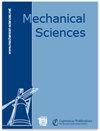风力机液-机混合动力传动技术的可行性及动态性能分析
IF 1.5
4区 工程技术
Q4 ENGINEERING, MECHANICAL
引用次数: 2
摘要
摘要为了克服齿轮系和静液压传动系统各自的缺点,建立了一个基于液压机械混合动力传动技术的风力发电系统多体动力学模型并进行了仿真。HMHPT是一个单级齿轮系(SSPGT)和典型HPT的混合概念。SSPGT的输入轴与涡轮机转子相连,而SSPGT的输出轴与液压泵的轴相连。液压泵为液压马达提供流量,其轴与发电机相连。现有的750涡轮叶片模型 基于千瓦的风力涡轮机用于HMHPT的进一步开发和分析。模拟响应表明,在风力涡轮机中使用HMHPT可以提高发电量和控制潜力。此外,还解决了泵和电机泄漏变化对电机发电的影响。此外,还发现,如果在所提出的HMHPT中交换SSPGT和HPT的顺序,则系统响应的稳定时间、最大动脚和上升时间都会增加。结果,降低了系统的可控性。本文章由计算机程序翻译,如有差异,请以英文原文为准。
A feasibility and dynamic performance analysis of hydromechanical hybrid power transmission technology for wind turbines
Abstract. A multi-body dynamical model of a wind turbine power generation system (WTPGS) based on hydromechanical hybrid power
transmission (HMHPT) technology is developed and simulated to overcome the
individual drawbacks of the gear train and hydrostatic power
transmission (HPT) system. The HMHPT is a hybrid concept of a single-stage
planetary gear train (SSPGT) and a typical HPT. The input shaft of the SSPGT is coupled with the turbine rotor, whereas the output shaft of the SSPGT is coupled with the shaft of a hydraulic pump. The hydraulic pump supplies flow
to the hydro-motor, and its shaft is coupled with the generator. An existing
turbine blade model of 750 kW based wind turbine is used for further
development and analysis of the HMHPT. The simulation responses indicate
that the power generation and the control potential both have been
improved using the HMHPT in a wind turbine. Moreover, the influence on
the motor power generation due to variations of pump and motor leakages is
addressed. Additionally, it is found that if the order of the SSPGT and the
HPT are swapped in the proposed HMHPT, then the settling time, maximum
overshoot, and rise time of the system responses are increased. As a result,
the controllability of the system is decreased.
求助全文
通过发布文献求助,成功后即可免费获取论文全文。
去求助
来源期刊

Mechanical Sciences
ENGINEERING, MECHANICAL-
CiteScore
2.20
自引率
7.10%
发文量
74
审稿时长
29 weeks
期刊介绍:
The journal Mechanical Sciences (MS) is an international forum for the dissemination of original contributions in the field of theoretical and applied mechanics. Its main ambition is to provide a platform for young researchers to build up a portfolio of high-quality peer-reviewed journal articles. To this end we employ an open-access publication model with moderate page charges, aiming for fast publication and great citation opportunities. A large board of reputable editors makes this possible. The journal will also publish special issues dealing with the current state of the art and future research directions in mechanical sciences. While in-depth research articles are preferred, review articles and short communications will also be considered. We intend and believe to provide a means of publication which complements established journals in the field.
 求助内容:
求助内容: 应助结果提醒方式:
应助结果提醒方式:


